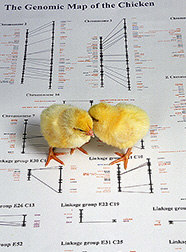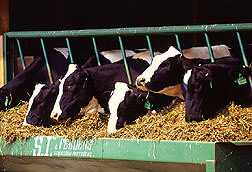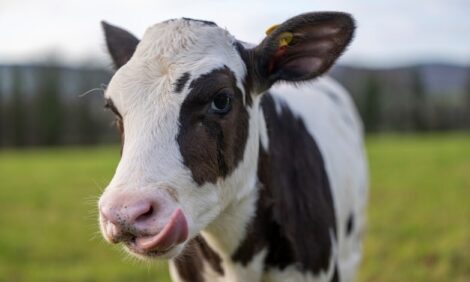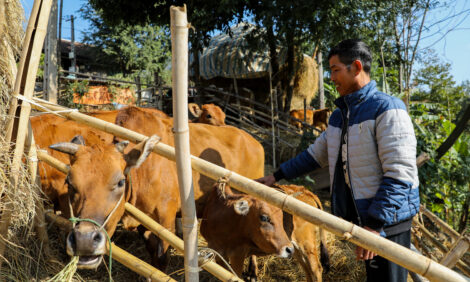



Health and Meat Animal Production
By the USDA's Agricultural Research Service - An ounce of prevention is worth a pound of cure—particularly when it comes to medicine.I Dream of Genomics
A house built on a solid foundation is better equipped to withstand the ravages of weather and time. Similarly, animals with a solid genetic inheritance are more likely to resist certain diseases. Genomics research at ARS labs throughout the United States addresses this issue by mapping animal genomes, identifying significant genes and providing tools to help guide producers' decisions.
 |
Molecular virologist Stephen Spatz, of the Southeast Poultry Research Laboratory in Athens, Ga., and molecular biologist Robert Silva, of ADOL, initiated a comparative genomics program to investigate the differences in variants of MDV and identify predictors of virulence shifts. By examining the genetic differences between strains of MDV, the researchers hope to identify the genes that determine the pathogenesis of the virus. Identifying these genes will enable researchers to develop new, improved vaccines to protect chickens against currently circulating field strains, as well as those that may develop in the future.
In March 2000, researchers from the ARS Henry A. Wallace Beltsville (Md.) Agricultural Research Center (BARC) and the University of Vermont cloned a Jersey cow. She was genetically altered to secrete a naturally occurring, antimicrobial protein called lysostaphin into her milk, where it kills a major bacterial cause of mastitis. Even with existing treatments, mastitis costs the U.S. dairy industry about $1.7 billion every year. In tests conducted at BARC's Biotechnology and Germplasm Laboratory, three genetically engineered cows demonstrated significantly greater resistance to Staphylococcus aureus than a control group.
Another genomics study helped develop new tests to identify the bacteria that cause Johne's disease, an intestinal disease that afflicts cattle and other ruminants. Researchers at the National Animal Disease Center, in Ames, Iowa, and colleagues at the University of Minnesota sequenced the genome of Mycobacterium paratuberculosis, the disease's causative agent. Then they developed tests that can detect the microbe's presence in a fecal or milk sample within 72 hours, allowing producers to rapidly identify and isolate infected animals. In addition, researchers at both institutions are currently using the genome sequence to identify the best antigens to use in diagnostic assays.
Chill Out!
Stress in animals can foster poor health, reduced weight and, in the worst cases, death. Helping animals "keep their cool" can promote productive efficiency.
Three factors influence an animal's stress level: the environment, management practices and individual susceptibility. At the Roman L. Hruska U.S. Meat Animal Research Center (USMARC) in Clay Center, Neb., agricultural engineer Tami Brown-Brandl and her colleagues are developing a model for analyzing these influences and predicting an individual's stress level. The model also indicates a degree of certainty for each prediction, allowing producers to modify their responses accordingly.
Having the ability to identify animals with greater susceptibility to heat stress would allow producers to separate them and give them special care. The model could also monitor weather, helping them respond to environmental extremes. And producers could compare how different management strategies impact stress, enabling them to make the best decisions for the well-being of their herds.
In a separate study, Ted Elsasser, with the BARC Growth Biology Laboratory, is investigating whether vitamin E could be used to treat stress. Early studies suggest that preventative doses of vitamin E—which might be administered in anticipation of birth or weaning stress—may forestall the complications of oxidative stress, decrease susceptibility to infection and maintain growth rates in young cattle. If vitamin E proves to be an effective intervention treatment, this could translate into lower treatment costs, decreased antibiotic use and, ultimately, a healthier product for consumers.
Food, Glorious Food
Nutrition is another essential element of animal well-being. One way to ensure that animals eat a healthy diet is to have the highest quality forage available to them. Dozens of research projects within the ARS Rangeland, Pasture and Forages National Program are designed to improve our nation's forage supply and teach producers how to use it most effectively. (See HA issue 26.)
 |
A new program at USMARC and the Fort Keogh Livestock and Range Research Laboratory at Miles City, Mont., will aim at reducing cattle production costs by increasing feed efficiency. Currently, feed makes up 65-75 percent of beef production costs. The research will attempt to identify genes and other factors that influence efficient use of nutrients. Increasing efficiency will reduce costs and minimize the industry's environmental impact.
These are only a few of the current ARS research programs designed to promote animal welfare and improve production. Together, they help ensure that the United States maintains one of the strongest animal production industries in the world.
November 2006


